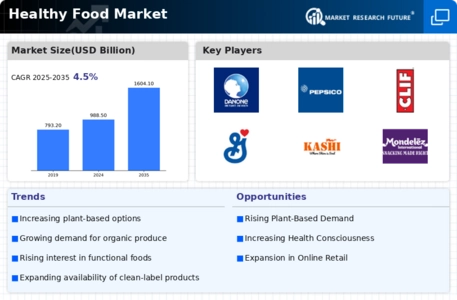Healthy Food Market Summary
As per MRFR analysis, the Healthy Food Market Size was estimated at 988.46 USD Billion in 2024. The Healthy Food industry is projected to grow from 1032.96 USD Billion in 2025 to 1604.47 USD Billion by 2035, exhibiting a compound annual growth rate (CAGR) of 4.5 during the forecast period 2025 - 2035.
Key Market Trends & Highlights
The Healthy Food Market is experiencing a transformative shift towards plant-based and functional products driven by health consciousness and sustainability.
- The rise of plant-based products is reshaping consumer preferences, particularly in North America, the largest market.
- Clean labeling continues to gain traction, reflecting a growing demand for transparency in food ingredients across the Asia-Pacific region.
- Technological integration in food production is enhancing efficiency and product quality, particularly in the functional food segment, which remains the largest.
- Increased health awareness and the demand for sustainability are key drivers propelling the growth of low-calorie and functional food segments.
Market Size & Forecast
| 2024 Market Size | 988.46 (USD Billion) |
| 2035 Market Size | 1604.47 (USD Billion) |
| CAGR (2025 - 2035) | 4.5% |
Major Players
Nestle (CH), PepsiCo (US), Danone (FR), General Mills (US), Kraft Heinz (US), Unilever (GB), Coca-Cola (US), Mondelez International (US), Hormel Foods (US)


















Leave a Comment